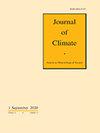Simulated Warming Hole in Paleo-Pacific Oceans
IF 4
2区 地球科学
Q1 METEOROLOGY & ATMOSPHERIC SCIENCES
引用次数: 0
Abstract
Abstract Both observations and simulations show that under global warming there exists warming deficit in the North Atlantic, known as the North Atlantic warming hole (NAWH). Here we show that similar warming hole occurs in the sub-polar Pacific ocean of paleo-climate simulations. As solar constant is increased, local surface becomes substantially cooler rather than warmer in the sub-polar paleo-Pacific ocean under the land-sea configurations of 70, 90, and 150 million years ago (Ma). The warming hole has a magnitude of ≈3 °C and locates in the Northern Hemisphere in 70Ma and 90Ma. The warming hole in 150Ma has a magnitude of ≈1 °C and locates in the Southern Hemisphere. Both atmospheric and oceanic processes contribute to trigger the warming hole. For 70Ma and 90Ma experiments, atmospheric teleconnection along a great circle from tropics to extratropics intensifies surface winds over sub-polar ocean and thereby increases relatively cool seawater transport from high to low latitudes. Meanwhile, global meridional overturning circulation (GMOC) becomes weaker, causing a divergence of the meridional ocean heat transport in the warming hole region. An increasing of regional cloud shortwave cooling effect acts to further enhance the warming hole. For 150Ma experiments, the warming hole is related to the meridional shift of mid-latitude jet stream and the weakening of GMOC in the Southern Hemisphere. The strength and phase of the atmospheric teleconnection and the response of GMOC strongly depend on land-sea configuration, resulting to the paleo-Pacific warming hole to occur in special periods only.古太平洋海洋中的模拟暖洞
摘要 观测和模拟结果都表明,在全球变暖的情况下,北大西洋存在暖赤字,即所谓的北大西洋暖洞(NAWH)。在这里,我们展示了在古气候模拟中,亚极地太平洋也出现了类似的暖洞。随着太阳常数的增加,在 7000 万年前、9000 万年前和 1.5 亿年前(Ma)的海陆配置下,次极地古太平洋的局部地表变得更冷而不是更暖。在距今 7000 万年和 9000 万年前,变暖洞的大小≈3 ℃,位于北半球。距今 1.5 亿年前的变暖洞温度≈1 ℃,位于南半球。大气和海洋过程都是引发暖洞的原因。在 70Ma 和 90Ma 的实验中,从热带到外热带沿一个大圆的大气远缘联系加强了副极地海洋上空的海面风,从而增加了相对较冷的海水从高纬度向低纬度的输送。与此同时,全球经向翻转环流(GMOC)变得更弱,导致暖洞区域的经向海洋热输送出现分流。区域云短波冷却效应的增加进一步加剧了暖洞。在 150Ma 实验中,暖洞与中纬度喷流的经向移动和南半球 GMOC 的减弱有关。大气远程联系的强度和相位以及全球海洋观测变化的响应在很大程度上取决于海陆配置,从而导致古太平洋暖洞只出现在特殊时期。
本文章由计算机程序翻译,如有差异,请以英文原文为准。
求助全文
约1分钟内获得全文
求助全文
来源期刊

Journal of Climate
地学-气象与大气科学
CiteScore
9.30
自引率
14.30%
发文量
490
审稿时长
7.5 months
期刊介绍:
The Journal of Climate (JCLI) (ISSN: 0894-8755; eISSN: 1520-0442) publishes research that advances basic understanding of the dynamics and physics of the climate system on large spatial scales, including variability of the atmosphere, oceans, land surface, and cryosphere; past, present, and projected future changes in the climate system; and climate simulation and prediction.
 求助内容:
求助内容: 应助结果提醒方式:
应助结果提醒方式:


